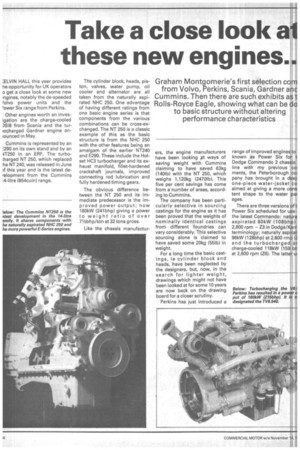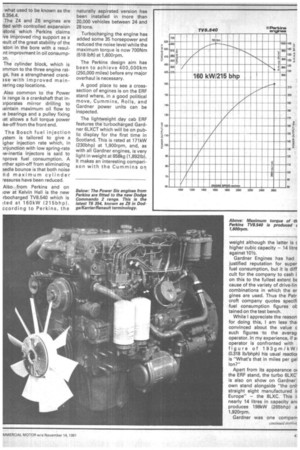Take a close look al these new engines..
Page 34

Page 35

Page 36

If you've noticed an error in this article please click here to report it so we can fix it.
Graham Montgomerie's first selection corn from Volvo, Perkins, Scania, Gardner anc Cummins. Then there are such exhibits as t Rolls-Royce Eagle, showing what can be do to basic structure without altering performance characteristics
:ELVIN HALL this year provides he opportunity for UK operators D get a close look at some new ingines, notably the de-speeded folvo power units and the 'ower Six range from Perkins.
Other engines worth an invesigation are the charge-cooled )Si8 from Scania and the turoocharged Gardner engine aniounced in May.
Cummins is represented by an 290 on its own stand and by an +IT250 in an ERF. The turbo:harged NT 250, which replaced he NT 240, was released in June yf this year and is the latest defelopment from the Cummins 14-litre (854cuin) range. The cylinder block, heads, piston, valves, water pump, oil cooler and alternator are all taken from the naturally aspirated NHC 250. One advantage of having different ratings from one basic engine series is that components from the various combinations can be cross-exchanged. The NT 250 is a classic example of this as the basic structure is from the NHC 250 with the other features being an amalgam of the earlier NT240 and E290. These include the Holset HC3 turbocharger and its exhaust manifold, fillet-hardened crackshaft journals, improved connecting rod lubrication and fully hardened timing gears.
The obvious difference between the NT 250 and its immediate predecessor is the improved power output; now 180kW (241bhp) giving a power to weight ratio of over 71/2bhp/ton at 32 tons gross.
Like the chassis manufactur ers, the engine manufacturers have been looking 4at ways of saving weight with Cummins claiming to have saved 63kg (140Ib) with the NT 250, which weighs 1,120kg (2470Ib). This five per cent savings has come from a number of areas, according to Cummins.
The company has been particularly selective in sourcing castings for the engine as it has been proved that the weights of nominally identical castings from different foundries can vary considerably. This selective sourcing alone is claimed to have saved some 20kg (551b) in weight.
For a long time the basic castings, ie cylinder block and heads, have been neglected by the designers, but, now, in the search for lighter weight, drawings which might not have been looked at for some 10 years are now back on the drawing board for a closer scrutiny.
Perkins has just introduced a range of improved engines to known as Power Six for t Dodge Commando 2 chasSis. line with my previous coi ments, the Peterborough coi pany has brought in a deer one-piece water-jacket co aimed at giving a more cons tent shape to the water 'paa ages.
There are three versions of t Power Six scheduled for tree the latest Commando: natura aspirated 80kW (108b4)1 2,800 rpm — Z3 in Dodge/k/arn terminology; naturally asplrat 96kW (128bhp) at 2,800 rmja (2 and the turbocharged all charge-cooled 118kW (159 bh at 2,600 rpm (Z6). The latter ui what used to be known as the 6.354.4.
The Z4 and Z6 engines are tted with controlled expansion .stons which Perkins claims 've improved ring support as a isuit of the great stability of the
ston in the bore with a resul nt improvment in oil consume)n.
The cylinder block, which is )mmon to the three engine ratgs, has a strengthened crankse with with improved mainmring cap locations.
Also common to the Power ix range is a crankshaft that in)rporates mirror drilling to iaintain maximum oil flow to ie bearings and a pulley fixing iat allows a full torque power ke-off from the front end.
The Bosch fuel injection 'stem is tailored to give a igher injection rate which, in )njunction with low spring-rate .w-inertia injectors is said to lprove fuel consumption. A irther spin-off from eliminating Bede bounce is that both noise nd maximum cylinder -essures have been reduced.
Also from Perkins and on low at Kelvin Hall is the new rbocharged TV8.540 which is ited at 1 6 OkW (21 5bhp). ccording to Perkins, the naturally aspirated version has been installed in more than 20,000 vehicles between 24 and 28 tons.
Turbocharging the engine has added some 35 horsepower and reduced the noise level while the maximum torque is now 700Nm (518 lbft) at 1,600rpm.
The Perkins design aim has been to achieve 400,000km (250,000 miles) before any major overhaul is necessary.
A good place to see a crosssection of engines is on the ERF stand where, in a good political move, Cummins, Rolls, and Gardner power units can be inspected.
The lightweight day cab ERF features the turbocharged Gardner 6LXCT which will be on public display for the first time in Scotland. This is rated at 171kW (230bhp) at 1,900rpm, and, as with all Gardner engines, is very light in weight at 858kg (1,8921b). It makes an interesting comparison with the Cummins on weight although the latter is higher cubic capacity — 14 litre against 101/2.
Gardner Engines has had justified reputation for super fuel consumption, but it is diff cult for the company to cash i on this to the fullest extent bE cause of the variety of drive-lin combinations in which the er gines are used. Thus the Patr croft company quotes specifi fuel consumption figures a tamed on the test bench.
While I appreciate the reason for doing this, I am less thal convinced about the value c such figures to the averag. operator. In my experience, if al operator is confronted with . figure of 1 9 3 gm/kWI (0.318 lb/bhph) his usual reactor is "What's that in miles per gal Ion?"
Apart from its appearance oi the ERF stand, the turbo 6LXC"
is also on show on Gardner'. own stand alongside "the onl, straight eight manufactured ir Europe" — the 8LXC. This nearly 14 litres in capacity an produces 198kW (265bhp) a 1,92Orpm.
Gardner was one compare vhich came to turbocharging • ather late and IVECO was mother. It was only last month iiihen the 170.30 chassis was aunched complete with turbo:harged six-cylinder engine. rhis engine is on show at Kelvin iall in two tractive units and it rroduces 233kW .(299bhp). This s a Fiat designed water-cooled rngine although as is becoming he norm these days any inormation from IVECO stuliously ignores any reference to rither Fiat or Magirus Deutz.
This particular Fiat engine was lot exactly renowned for its tor'Lie curve in its earlier days, but urbocharging has changed all hat. The maximum torque is rnw 1325Nm (977Ibft) and as rur recent road test showed CMOctober 10) the 17.30 is a fery driveable vehicle.
The equivalent air-cooled )eutz-engined chassis, the 290M 9 F5, is expected earlier next fear — no doubt in IVECO form, ether than Magirus.
Scania also has a new engine it Kelvin Hall, in the shape of the urbocharged and charge-cooled rSi8. This produces 172kW 231bhp) and goes some way toyards filling a power gap in the ;cania engine range.
The DSi8 is somewhat unisual in the inlet charge cooling ;cene in that it is an air to water system. Normally, this system is used by engine manufacturers who are not also chassis manufacturers, as it can be assembled as a self-contained unit. Air-toair systems which use a lot of trunking rely on the co-operation of the chassis manufacturer to get it right, but such a system is more efficient in terms of temperature drop.
The DSi8 engine is worth a close look as it is a remarkably tidy installation with a small built-in charge-cooling radiator.
On the Volvo stand two of the new Lugger Line range of engines can be seen. At the top of the power sector, the TD 120FC is turbocharged and chargecooled (using an air-to-air system) to produce 265kW (355bhp) and it makes an interesting installation comparison with the Scania DSi 8.
Possibly of more interest to the UK operator is the TD 100GA, the new engine for the F10. This is the latest development of the familiar 9.6 litre six-cylinder engine and it now develops 192kW (257bhp) at 2,050 rpm. This is a reduction in maximum power compared with the previous TD100 B engine and it occurs at a maximum rated speed some 150rpm lower as Volvo is now following its competitors along the low-engine-speed path.
The maximum torque of the GA is 1,060Nm (779Ibft), which is a small improvement over the earlier engine. The crux of the Volvo argument in favour of the new engine is that the useful tor que is available over a wider speed range.
The basic engine specification remains the same, but there have been a number of detail changes including inlet and exhaust manifolds and the turbocharger.
The major items of interest in the Leyland engine range are the latest versions of the 400-Series. The Freighter (the Clydesdale replacement) comes with a choice of the naturally aspirated 402 or the turbocharged 411. The Reiver replacement known as the Constructor 24.15 comes with the 411 turbo engine only.
The 402 is rated at 100kW (135bhp) at 2,600rpm with a maximum torque of 415Nm (306 lbft) at 1,600rpm. The turbocharged 411 now develops 115kW (154bhp) and 488Nm (360 lbft) at the same respective engine speeds.
The main feature of the RollsRoyce attack this year is the 290L. This is a turbocharged unit which produces 216kW (290bhp) at 1,950rpm and 1,190Nrn (8781bft) torque at 1,350rpm.
As with other RR engines, the 290L has had a weight reduction exercise carried out on it with 'new features including a shallower sump and a redesigned flywheel housing.
The Rolls-Royce Eagle Series is another example of what can be done to the basic engine structure without altering the performance characteristics of the engine.
During the production life of a major casting like a cyfinI block, various bosses and tend to be incorporated into I design as production proqesi change. These have nothing' do with the design itself; are there for reasons of ease handling during machining.
But when a machining prop is changed, new locating bosi are added without removing 1 .old ones, so the casting terodl
grow" and in this cont equals increased weight.
What Roils-Royce has (lona to take the casting drawings a eliminate all redundant lodati bosses, which has achieved significant weight saving.
In the Bedford range, I availability of turbocharged gines has been extended to clude two more variants. 130TD version of the Blue $eij engine develops 97kW (131)131 and it is now available in the 750, 1020, and 1260 mod while the 175TD (130kW 173bhp) is an option for the 1470 and 1630 chassis.
A "first timer" at the Scott Show is a TM2600 6 x 4 viiK features the 155kW (208b1 version of Bedford's 8.2-11 (500cuin) engine.






















































































